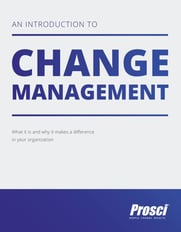Change is inevitable. Whether a new technology or process is being adopted or there are shifts happening within departments, it’s important to make changes as seamless as possible to prevent long-lasting disruptions, reduce productivity dips and drive organisational success. That’s what makes the role of a change management practitioner so vital to the process.
Whether you’re considering applying to become a change management practitioner or your company is looking to hire someone to implement change within your organisation, we’ve put together four critical skills we know help make a great Change Management Practitioner.
Download: An Introduction to Change Management
Commitment –
Change leadership isn’t just about helping members of your team adjust to new change initiatives smoothly. To successfully implement change and give the best training required for a successful uptake, change management practitioners themselves must commit to the change in all aspects. Not only should they be committed to following the change through, but also react to any unpredicted hurdles that occur. Certain members within a team might require more training than was initially planned, and a committed change management practitioner will work with the line manager to sense and facilitate the right corrective actions. It’s important for the change management practitioner to ensure everyone is on board with the change and has received the appropriate levels of training in the new ways of working required to ensure that change is fully adopted and delivers its intended business results.
Communication –
For change leaders, it’s important to think of communication as a two-way street. Not only should you communicate your reasoning behind this path to change clearly and using consistent, common language, but you should also remain open to any opinions and suggestions that you receive back whether they are positive or negative. Remember to be empathetic and see things from the team’s point of view to fully understand which problems they are looking to solve and how implementing suggested changes will impact this. Focusing on the ‘why’ as well as the ‘what’ of the change won’t only show you as an authentic change leader but will help encourage a stronger buy-in and urgency for change. Great change management practitioners coach their leaders and line managers in how to be great communicators.
Collaboration -
Having an open communication method when implementing your change initiative can only bring about a collaborative effort. Including members of the organisation in the decision-making process early makes them feel included, reduces their personal resistance to the change, encourages a sense of ownership and strengthens their decision to go ahead with the suggested change.
Not only should change leaders collaborate with members of the organisation to encourage change, but a great change leader helps break down organisational silos and encourages collaboration between the employees and departments who may not ordinarily communicate to unite them towards a common goal. This gives a chance for those who may not normally be involved in the decision-making process to have their voice and opinion heard by higher-ranking members of the team. Great change management practitioners schedule and coach leaders and line managers to have these cross functional conversations in support of driving greater adoption of the change
Creativity -
It’s natural to be intimidated by the idea of change. A change management practitioner’s role is to tap into the imagination of those within the organisation and if as a sponsor or line manager they are a preferred sender in this change, encourage them to pass on their vision to other directly impacted staff members as consistently and frequently as possible. Getting creative with the way you train and implement change can help the team find it easier to come on board.
Encountering a difficult and volatile environment that isn’t open to your new ideas for change means change management practitioners will have to get creative with the way they ensure the change is presented to the organisation. Prosci's Best Practices research on Communications lists more than 100 ways of communicating the same messages in a variety of compelling ways. Incorporating new ideas that arise in initial discussions requires creativity to react and adapt your current change model appropriately.
How can I learn more?
If you would like to learn more about these 4 critical change management practitioner skills and develop your career in change management then why not participate in the three day CMC Prosci® Certified Change Management Practitioner course? Find out more or download the brochure.
You'll learn Prosci® methodology and apply tools from an online toolkit for managing change effectively within your project. Participants in this three day programme can qualify as certified practitioners of Prosci’s research-based change management methodology and take the first step toward becoming a Certified Change Management Professional.
Take a look at our FREE Prosci change management webinar! Our webinars offer an insight into the forefront of change management thinking, delivered by CMC Change Management Practitioners. Whether you're new to change management, or are seasoned in the people side of change, there is a topic for you. Attend a live session, or see what we've got available on-demand.



